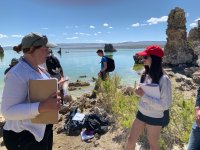How to Set Up Rich Experiential Learning Units
Two teachers who guided a project-based learning unit that included travel share how to replicate the deep engagement they saw without going anywhere.
Your content has been saved!
Go to My Saved Content.Our independent school recently redesigned the schedule to allow for two 3-week-long immersive courses each academic year. We anticipated that devoting that time to a single interdisciplinary, project-based course could be transformative for our students, but we didn’t imagine the deep impact it would have on us as educators.
We hope to explain how rich experiential learning like the project we describe here can be implemented in other schools. Several key elements stand out: an authentic, multidisciplinary essential question; scaffolds to maximize student-directed learning and community-building; and access to outside experts and engaged citizens who were interested in exploring questions with high school students.
Our course, “Water in the American West: History, Policy, and Science,” explores the essential question “Whose water is it?” During this course, we traveled with our students to the eastern Sierra Nevada of California, an arid environment with extremely limited water availability and a long and storied history of water conflicts. Students explored the aquatic ecosystems of the area to understand how organisms rely on water, and did fieldwork including gathering of specimens, exploring sites, investigating archival primary sources, and discussing issues with local residents, including scientists, environmental activists, policy makers, indigenous tribal members, and ranchers.
We then asked our students to approach the essential question from the perspective of one of these stakeholders and conduct scholarly research as well as an additional interview with a member of that stakeholder group.
Transferring What We Learned to Other Schools
As we contemplate ways to replicate the transformative power of this immersive course in our typical semester courses, we have realized that the three points below are applicable in any school or classroom looking to foster the deep learning we saw in our students. The travel experiences our students had were powerful, but are not required to motivate students to take ownership of their learning.
1. The importance of the essential question: A simple but complex essential question is concrete and relates to students’ lives while inviting alternative answers from multiple perspectives. In our case, access to water is fundamental to life, and the question of who has the right to use it brings up strong initial responses in most students.
This creates immediate interest and buy-in, and sets up a learning environment in which students really want to work to discern how to fairly allocate this resource. This is clearly replicable within any classroom.
2. Scaffolding for student-centered learning: Knowing that we wanted students to grapple with the essential question throughout the course, we began by creating a culminating assessment that would compel them to do so. Students would exhibit their learning about one of the stakeholder groups’ response to the essential question by collaborating in small groups to create a research paper and an informative poster, which they would present to the school community.
After crafting project requirements that spelled out our expectations for research, drafting, and the final products, we worked backward to build a series of activities and materials that would provide students a foundation and then progressively give them more control over their learning.
Students moved from activities and sources that were small in scope to fieldwork involving gathering and testing scientific data, exploring local primary sources in a regional museum, and touring key locations with local activists and experts. Eventually, students moved on to conducting interviews with stakeholders and drafting the research paper.
These experiences were the most time-consuming to arrange and the ones over which we had the least control as teachers since they were truly experiential and subject to many variables, not least of which was the spontaneous exchange of ideas between local residents and our students. Numerous times a speaker or a student made a comment or asked a question that tied multiple thematic threads together at just the right moment. Those moments would not have happened without the essential question and the scaffolding.
The final stage of the course followed a workshop model in which we stepped into the background, serving as coaches while students organized themselves, identified additional resources and interviews they wanted to conduct, and completed their projects.
3. Involvement with the community: Perhaps the most important factor in the success of this course was the degree to which students had opportunities to work directly with passionate members of their stakeholder groups. By researching and networking months in advance, we were able to recruit deeply knowledgeable scientists, environmental activists, and local residents. Students were able to frame their research and conclusions based on what they learned in conversation with actual stakeholders, and in turn authentically represented these groups.
In several cases, we saw students’ preconceptions shattered as they developed empathy with the people they interviewed. This was how the course went from “interesting” to “transformational.” The complexity of the issues around our essential question became very real as students formed relationships with stakeholders and gained compassion for a community wrestling with a complex issue. Though the community was not directly the students’, the question has direct relevance throughout the arid region our students inhabit.
This deep engagement with a community need not involve long trips: Teachers can set up an essential question based on the local community, or they can bring students into contact with more distant groups via video meetings.
These three elements—the heart of successful experiential and project-based learning—made it possible to put the reins of learning solidly in the hands of the learners in a way that excited, motivated, and propelled them forward.
